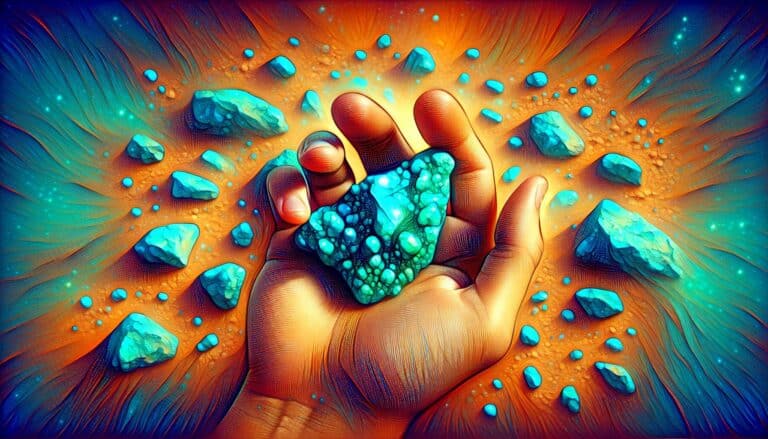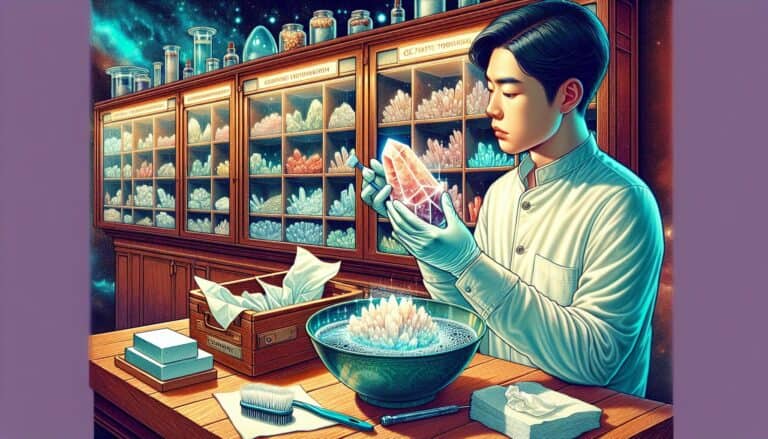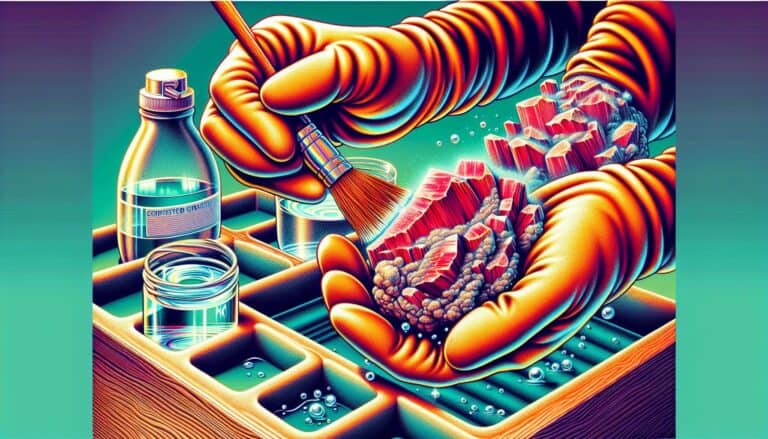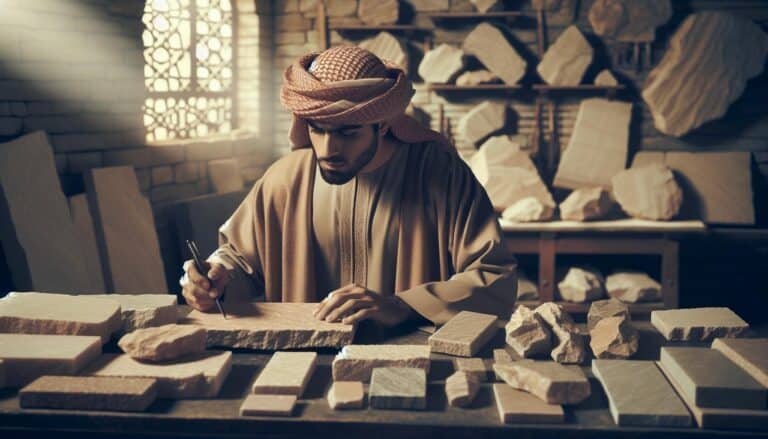Discovering the vibrant world of minerals, you might’ve stumbled upon the striking beauty of brazilianite.
This gemstone, with its unique green-yellow hue, is not just a collector’s delight but also a treasure for gem enthusiasts. But how can you be sure you’ve found authentic brazilianite?
Knowing what sets brazilianite apart is key. It’s not just about the color; it’s about understanding its distinct features and where it’s typically found. With the right knowledge, you’ll be able to identify brazilianite like a pro, ensuring that your collection is as genuine as it is stunning.
Let’s dive into the characteristics that make brazilianite a standout.
To identify authentic brazilianite, observe its yellow-green hue and glassy luster. Perform a white streak test and check for non-magnetism. Brazilianite’s hardness is 5.5-6 on the Mohs scale, and it displays weak birefringence and double refraction. Its refractive index ranges from 1.602 to 1.621, with a specific gravity of 2.98-3.03.
How to Identify brazilianite Through Testing
When you come across a gemstone that you suspect to be brazilianite, there are a number of tests you can conduct to verify its authenticity. From simple visual inspections to more complex refractive index tests, these methods will provide you with a clearer idea of whether you’ve found a genuine brazilianite sample.
Visual Inspection
Visual inspection is your first line of defense against counterfeit gemstones. Brazilianite has a unique yellow-green to olive-green color that is rarely mimicked perfectly by imitations. Check for the glassy luster and inspect the crystal for transparency. Inclusions are common, but they’re typically not dense enough to obstruct the gemstone’s natural beauty.
The Streak Test
Performing the streak test is as simple as rubbing the gemstone across a piece of unglazed porcelain tile. Genuine brazilianite leaves a white streak. Any deviation in color could indicate that the specimen in question is not authentic brazilianite.
Magnet Test
Brazilianite is not magnetic, so if your stone is attracted to a magnet, it’s likely not a true piece. Keep a strong magnet handy to rule out any iron-containing impostors.
Hardness Test
Using Mohs scale of mineral hardness is an effective way to determine brazilianite. Brazilianite falls between 5.5 to 6 on the scale. Try scratching your specimen with a steel knife (5.5) or a glass plate (5.5). If it scratches the knife or the glass, it could indeed be brazilianite.
Birefringence Test
Birefringence refers to a material’s ability to refract light at two different speeds. Brazilianite has weak birefringence which can be observed with a polariscope. If you notice the characteristic doubling of backlit images, this is a positive indication of brazilianite.
Checking The Diaphaneity
Diaphaneity, or the gemstone’s transparency, is a tell-tale sign. Brazilianite ranges from transparent to translucent. Hold the stone up to light and observe its translucency. An opaque result likely disqualifies it as authentic brazilianite.
Single or Double Refraction
Brazilianite is a doubly refractive material which means when you look through the stone, you’ll see two light paths. Using a dichroscope can help you easily identify this property and confirm the gemstone’s identity.
Refractive Index Test
A refractometer measures the refractive index of your gemstone which is crucial in gemstone identification. Brazilianite has a refractive index range of 1.602 to 1.621. A deviation outside this range would suggest that the gemstone is not brazilianite.
| Property | Brazilianite Index Range |
|---|---|
| Refractive | 1.602 to 1.621 |
Finding The Specific Gravity
The specific gravity (SG) of brazilianite is typically between 2.98 to 3.03. To check, use a hydrostatic balance or a SG testing kit. An SG outside this range could mean the stone is not genuine.
| Property | Brazilianite SG Range |
|---|---|
| Specific Gravity | 2.98 to 3.03 |
Identifying Brazilianites in the Field
When you’re out in the field, look for brazilianite at granite pegmatites or phosphate-rich areas. Often found in association with muscovite and albite, identifying the surrounding rock can lead you to brazilianite.
Recognizing Potential Brazilianite Rocks
Rocks that could potentially bear brazilianite will often have distinct phyllosilicates or show signs of phosphate activity. In the field, these rocks may also display the characteristic green tones of the gemstone protruding from them.
By understanding and applying these tests, you’ll enhance your ability to distinguish real brazilianite from mere look-alikes. Remember, while these tests can guide you, consulting with a professional geologist or certified gemologist could provide the most reliable confirmation of your find.
Physical Characteristics of brazilianites

When exploring the properties that make Brazilianite unique, it’s essential to consider its physical attributes. You’ll notice that Brazilianite typically displays a pleasing yellow-green color, often compared to that of a young olive. This gem’s vibrant hue may vary from pale to deep green, depending on the specimen.
Transparency is another key characteristic of Brazilianite, with most specimens ranking from translucent to transparent. This quality enhances the stone’s aesthetic appeal, as light can penetrate and interact with the inner structures of the gem, adding to its luster.
Apart from the visual allure, the crystalline structure of Brazilianite deserves attention. It crystallizes in the monoclinic system, showcasing prismatic or tabular forms which can be a strong indicator of authenticity when inspecting the mineral.
The gemstone’s luster ranges from vitreous to a pearly appearance on cleavage surfaces. When you handle Brazilianite, you’ll observe its glass-like shine, which contributes to its popularity among collectors and jewelry enthusiasts.
In terms of hardness, Brazilianite ranks at 5.5 to 6 on the Mohs scale, which means it’s relatively soft in comparison to other gems. This is a crucial factor to consider, especially if you’re planning to include it in jewelry, as it can be prone to scratches from daily wear.
| Attribute | Description |
|---|---|
| Color | Yellow-green, varies from pale to deep green |
| Transparency | Translucent to transparent |
| Crystalline Structure | Monoclinic, prismatic or tabular forms |
| Luster | Vitreous to pearly on cleavage planes |
| Hardness | 5.5 to 6 on the Mohs scale |
Understanding these physical characteristics not only aids in identification but also informs your decisions if you intend to purchase or work with Brazilianite. Remember, evaluating the mentioned aspects carefully will help in discerning the authenticity of the stone and its suitability for your needs.
How Are brazilianite Formed?
Brazilianite forms in unique geologic settings that you might find quite intriguing. It’s a phosphate mineral that often emerges in granite pegmatites, which are coarse-grained igneous rocks. These pegmatites form during the last stages of magma crystallization and are renowned for containing rare minerals.
Primary Formation
Brazilianite’s journey begins deep within the Earth’s crust. When magma cools slowly, it allows for the growth of large mineral crystals. Over time, the mineral-laden water within these formations cools and evaporates, leading to the crystallization of minerals like Brazilianite.
- Granite Pegmatites: Environments rich in volatile elements
- Crystallization: Slow cooling and spaces for crystal growth
- Mineral-Rich Waters: Formation from evaporating waters
Secondary Habitats
Not only does Brazilianite crystallize in primary geological settings, but it can also form as a secondary mineral. In these cases, it develops from existing phosphates due to chemical alterations caused by hydrothermal solutions. These solutions percolate through the rocks, facilitating the formation of new minerals in response to changes in pressure and temperature.
In your quest to identify Brazilianite, recognizing the environments where it forms can be as important as understanding its physical characteristics. Looking out for the typical granitic or hydrothermal geological settings can clue you in on whether you’re on the right track.
Preparation for brazilianite Hunting
Before you set out on your Brazilianite hunting adventure, it’s essential to gear up with the right tools and prioritize safety. The more prepared you are, the more successful your trip is likely to be.
Gathering the Right Tools
Essential tools make the search for Brazilianite crystals more effective. Here are the tools you’ll need:
- Geologist’s hammer: For carefully breaking rocks to access potential Brazilianite deposits.
- Chisel: To precisely split layers of rock and expose hidden gems.
- Safety goggles: To protect your eyes from flying debris.
- Gloves: To keep your hands safe from sharp rocks and edges.
- Backpack: To carry your equipment and any Brazilianite specimens you may find.
In addition to the basics, consider a handheld GPS device or reliable topographical maps of the area. Since Brazilianite is found in specific geological settings, a geological field guide can offer valuable insights on the best places to search.
Safety Considerations
Hunting for minerals like Brazilianite involves a few risks, and safety should be your top priority. Follow these guidelines to ensure a safe trip:
- Always let someone know where you’re going and when you expect to return.
- Study the terrain and weather forecast for the area to avoid surprises.
- Wear adequate clothing, including sturdy boots with ankle support.
- Carry a first aid kit equipped for cuts and abrasions.
- Bring enough water and snacks to stay hydrated and energized.
- Be aware of local wildlife and know how to respond if you encounter it.
Familiarize yourself with the local regulations of the area you’ll be exploring. Some regions may have restrictions or require permits for collecting minerals. Respect the environment by practicing leave no trace principles, ensuring that your search for Brazilianite has minimal impact on the natural setting.
Handling and Care of Found brazilianites

Cleaning and Storing Brazilianites
Once you’ve successfully located and extracted Brazilianite from its natural spot, it’s crucial to clean and store the crystals correctly to maintain their luster and value. Soft-bristled brushes are your best friend here; they remove debris without scratching the mineral’s surface. Use room-temperature water and avoid harsh chemicals, which can harm Brazilianite’s delicate structure. A mild soap is acceptable, but make sure you rinse the crystals thoroughly to prevent residue build-up.
Proper drying is just as essential. Gently patting the Brazilianites dry with a soft, lint-free cloth ensures no water spots form. For storing, opt for a fabric-lined jewelry box or a display case with padding. Wrapping them in acid-free tissue paper before storage also helps in preventing scratches.
Maintaining an optimal storage environment is key:
- Keep the Brazilianites away from direct sunlight, which can fade their vibrant colors.
- Store them in a dry location to prevent any moisture-induced damage.
- Avoid temperature extremes, as sudden changes can cause cracks.
Remember that even the most thorough cleaning can’t reverse natural wear and erosion, so handle your Brazilianites with the respect and care they deserve. They are not only geological wonders but tangible connections to the Earth’s deep history.
Moving from the cleaning and storing process, it’s essential to also consider the documentation and appraisal aspects, another significant step in your Brazilianite journey.
Conclusion: Confirming Brazilianite Real
You’ve now got the tools to confidently identify Brazilianite and ensure its longevity.
Remember, gentle cleaning and mindful storage are key to preserving your crystal’s luster. Keep it away from harsh sunlight and in a dry spot to maintain its beauty. Don’t forget to document your find and consider an appraisal for added peace of mind.
Armed with this knowledge, you’re ready to enjoy the unique charm of Brazilianite in your collection.



![SC Rockhounding Sites in [year]: Locations & Treasures](https://observationhobbies.com/wp-content/uploads/2024/01/iaWgmS5lbeH4osJUcBiPF-768x439.jpg)



